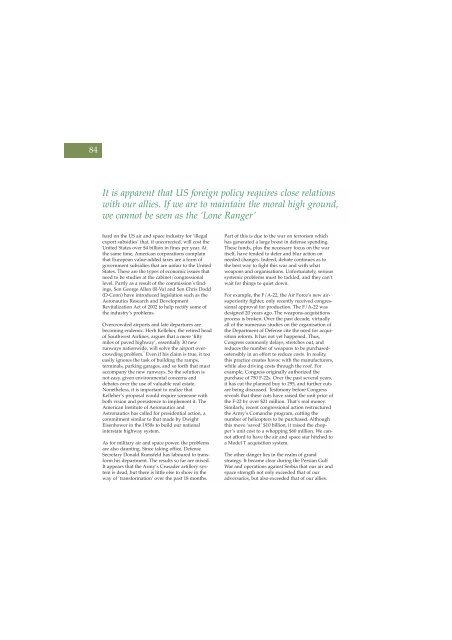Volume 6 No 4 - Royal Air Force Centre for Air Power Studies
Volume 6 No 4 - Royal Air Force Centre for Air Power Studies
Volume 6 No 4 - Royal Air Force Centre for Air Power Studies
You also want an ePaper? Increase the reach of your titles
YUMPU automatically turns print PDFs into web optimized ePapers that Google loves.
84<br />
It is apparent that US <strong>for</strong>eign policy requires close relations<br />
with our allies. If we are to maintain the moral high ground,<br />
we cannot be seen as the ‘Lone Ranger’<br />
hard on the US air and space industry <strong>for</strong> ‘illegal<br />
export subsidies’ that, if uncorrected, will cost the<br />
United States over $4 billion in fines per year. At<br />
the same time, American corporations complain<br />
that European value-added taxes are a <strong>for</strong>m of<br />
government subsidies that are unfair to the United<br />
States. These are the types of economic issues that<br />
need to be studies at the cabinet/congressional<br />
level. Partly as a result of the commission’s findings,<br />
Sen George Allen (R-Va) and Sen Chris Dodd<br />
(D-Conn) have introduced legislation such as the<br />
Aeronautics Research and Development<br />
Revitalization Act of 2002 to help rectify some of<br />
the industry’s problems.<br />
Overcrowded airports and late departures are<br />
becoming endemic. Herb Kelleher, the retired head<br />
of Southwest <strong>Air</strong>lines, argues that a mere ‘fifty<br />
miles of paved highway’, essentially 30 new<br />
runways nationwide, will solve the airport overcrowding<br />
problem. 1 Even if his claim is true, it too<br />
easily ignores the task of building the ramps,<br />
terminals, parking garages, and so <strong>for</strong>th that must<br />
accompany the new runways. So the solution is<br />
not easy, given environmental concerns and<br />
debates over the use of valuable real estate.<br />
<strong>No</strong>netheless, it is important to realize that<br />
Kelleher’s proposal would require someone with<br />
both vision and persistence to implement it. The<br />
American Institute of Aeronautics and<br />
Astronautics has called <strong>for</strong> presidential action, a<br />
commitment similar to that made by Dwight<br />
Eisenhower in the 1950s to build our national<br />
interstate highway system.<br />
As <strong>for</strong> military air and space power, the problems<br />
are also daunting. Since taking office, Defense<br />
Secretary Donald Rumsfeld has laboured to trans<strong>for</strong>m<br />
his department. The results so far are mixed.<br />
It appears that the Army’s Crusader artillery system<br />
is dead, but there is little else to show in the<br />
way of ‘trans<strong>for</strong>mation’ over the past 18 months.<br />
Part of this is due to the war on terrorism which<br />
has generated a large boost in defense spending.<br />
These funds, plus the necessary focus on the war<br />
itself, have tended to defer and blur action on<br />
needed changes. Indeed, debate continues as to<br />
the best way to fight this war and with what<br />
weapons and organisations. Un<strong>for</strong>tunately, serious<br />
systemic problems must be tackled, and they can’t<br />
wait <strong>for</strong> things to quiet down.<br />
For example, the F/A-22, the <strong>Air</strong> <strong>Force</strong>’s new airsuperiority<br />
fighter, only recently received congressional<br />
approval <strong>for</strong> production. The F/A-22 was<br />
designed 20 years ago. The weapons-acquisitions<br />
process is broken. Over the past decade, virtually<br />
all of the numerous studies on the organisation of<br />
the Department of Defense cite the need <strong>for</strong> acquisition<br />
re<strong>for</strong>m. It has not yet happened. Thus,<br />
Congress commonly delays, stretches out, and<br />
reduces the number of weapons to be purchasedostensibly<br />
in an ef<strong>for</strong>t to reduce costs. In reality,<br />
this practice creates havoc with the manufacturers,<br />
while also driving costs through the roof. For<br />
example, Congress originally authorized the<br />
purchase of 750 F-22s. Over the past several years,<br />
it has cut the planned buy to 295, and further cuts<br />
are being discussed. Testimony be<strong>for</strong>e Congress<br />
reveals that these cuts have raised the unit price of<br />
the F-22 by over $21 million. That’s real money.<br />
Similarly, recent congressional action restructured<br />
the Army’s Comanche program, cutting the<br />
number of helicopters to be purchased. Although<br />
this move ‘saved’ $10 billion, it raised the chopper’s<br />
unit cost to a whopping $60 million. We cannot<br />
af<strong>for</strong>d to have the air and space star hitched to<br />
a Model T acquisition system.<br />
The other danger lies in the realm of grand<br />
strategy. It became clear during the Persian Gulf<br />
War and operations against Serbia that our air and<br />
space strength not only exceeded that of our<br />
adversaries, but also exceeded that of our allies.
















